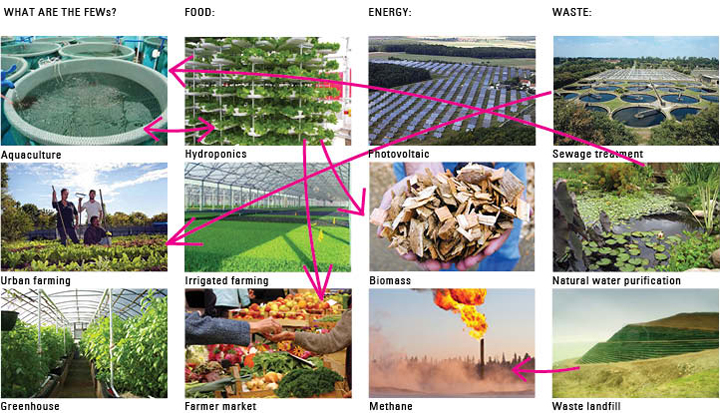|
 Practices related to Food, Energy and Waste form an ecosystem of interconnected components and hybrid systems, as they do not strictly belong to a single category: for instance, many plant species, such as corn, sorghum, or sugarcane, can be used either as food or as biomass to be converted into fibers or biofuel. Similarly, anaerobic digestion – in which microorganisms break down biodegradable material – is used for industrial or domestic purposes to manage waste and/or to release energy. Some processes are complementary: fish farming is often combined to natural filters, such as grass, to alleviate the waste content in the water. It can also be combined with hydroponics in a symbiotic environment, so that by-products from the aquaculture are filtered out by the plants as vital nutrients. Others are by-products of a first process: methane can be collected during waste processing in a landfill, where the gas is gathered, processed, and treated to produce electricity, heat, fuels, and various chemical compounds. Similarly, nutrient-rich digestate, the by-product of composting processes, can be used as fertilizer. Municipal solid waste is often used as source of biomass for generating electricity or to produce heat. Practices related to Food, Energy and Waste form an ecosystem of interconnected components and hybrid systems, as they do not strictly belong to a single category: for instance, many plant species, such as corn, sorghum, or sugarcane, can be used either as food or as biomass to be converted into fibers or biofuel. Similarly, anaerobic digestion – in which microorganisms break down biodegradable material – is used for industrial or domestic purposes to manage waste and/or to release energy. Some processes are complementary: fish farming is often combined to natural filters, such as grass, to alleviate the waste content in the water. It can also be combined with hydroponics in a symbiotic environment, so that by-products from the aquaculture are filtered out by the plants as vital nutrients. Others are by-products of a first process: methane can be collected during waste processing in a landfill, where the gas is gathered, processed, and treated to produce electricity, heat, fuels, and various chemical compounds. Similarly, nutrient-rich digestate, the by-product of composting processes, can be used as fertilizer. Municipal solid waste is often used as source of biomass for generating electricity or to produce heat.
|